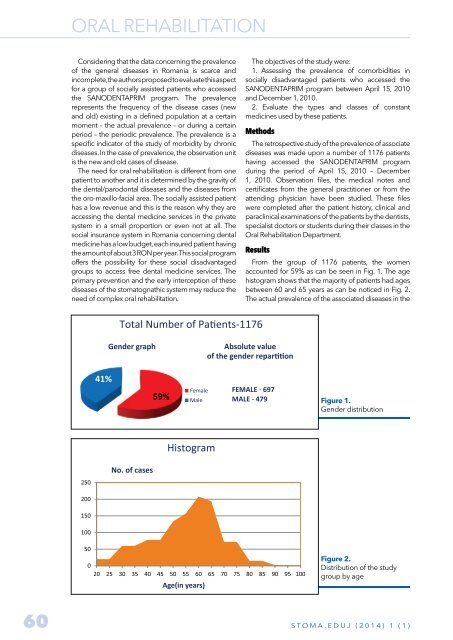Stomatology Edu Journal 1/2014
You also want an ePaper? Increase the reach of your titles
YUMPU automatically turns print PDFs into web optimized ePapers that Google loves.
An Implant Supported Maxillary Fixed Prosthesis<br />
with a Substructure/ Suprastructure Design: A Clinical Case<br />
Figure 1. Initial presentation (frontal view)<br />
Figure 2. Initial presentation (profile view)<br />
Figure 3. Intraoral frontal view<br />
The design of the final maxillary implant supported<br />
prosthesis is influenced by the following:<br />
1. The Anatomy of the residual ridge. The degree<br />
of ridge resorption can significantly alter the size<br />
and position of future implants and can determine<br />
whether teeth, or teeth and other tissues must be<br />
replaced (8).<br />
2. Some functional considerations include<br />
the opposing dentition, whether the patient<br />
has natural teeth or a removable prosthesis.<br />
Also, the maxillo-mandibular relationship is<br />
very important, as an increased vertical space<br />
and horizontal discrepancies create greater<br />
lever arms and complicate the design of the<br />
final prosthesis (9).<br />
3. Esthetics plays a crucial role in prosthesis<br />
design. Careful assessment of the patient’s smile<br />
line and necessity for a buccal flange must be<br />
performed before the final treatment plan decision<br />
is made (10).<br />
4. Altered speech can occur when patients<br />
cannot adapt to the new contours of the prosthesis.<br />
Implants placed too far palatally often require<br />
bulky restorations, which in turn can significantly<br />
alter speech (11).<br />
5. To promote favorable oral hygiene, access<br />
must be provided for effective removal of plaque<br />
and food debris from around the abutments and<br />
underneath the framework (12).<br />
6. Lastly, cost plays a significant role in selecting<br />
a prosthesis design. Usually suprastructure/<br />
Figure 4. Initial panoramic radiograph<br />
(the shadow is due to the screws)<br />
substructure cases require complex laboratory<br />
procedures and tend to be more costly.<br />
Some of the design options for a fixed maxillary<br />
implant supported prosthesis include the following:<br />
1. Ceramo-metal cement retained on custom<br />
abutments;<br />
2. Ceramo-metal screw retained prosthesis;<br />
3. Fixed-detachable or “hybrid” prosthesis;<br />
4. Suprastructure/Substructure design which can<br />
be achieved either by:<br />
-spark erosion technique<br />
-milled/ cast bar, cast suprastructure with set<br />
screws<br />
-milled bar with individual abutments and single<br />
crowns cemented on the abutments (13,14).<br />
The substructure/suprastructure design has its<br />
advantages and disadvantages.<br />
Some of the advantages of this type of design<br />
include providing the patient with a fixed prosthesis<br />
when no other designs are feasible. It also has the<br />
ability to replace both missing hard and soft tissue<br />
and improve unfavorable biomechanics seen in<br />
off-ridge relations (15). Esthetics and phonetics are<br />
usually very good with this type of design.<br />
However, there are also disadvantages to this<br />
design.<br />
The cost is usually very high due to precise<br />
and complicated laboratory procedures that are<br />
required and it unfortunately can be prohibitive for<br />
some patients. Passive fit of the bar and framework<br />
is also difficult to achieve. Long span frameworks<br />
53




